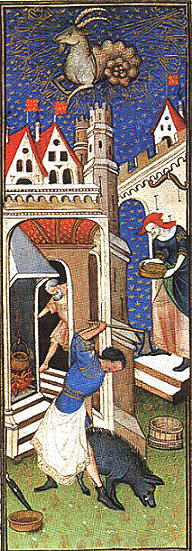Cuisine of Dorset facts for kids
The cuisine of Dorset is all about tasty, often simple, dishes. These foods traditionally come from the county itself, located in South West England. Today, Dorset's food scene focuses on organic and local produce. You can find these fresh ingredients at farmers' markets, farm shops, and special fairs held across Dorset.
Many traditional Dorset recipes are from the 17th and 18th centuries. Back then, most people worked on farms. Even though they grew most of the food, their diet was often quite basic. Richer families and farmers had more choices. Still, until the early 1800s, simple foods like bread were a huge part of everyone's diet.
History of Dorset Food
Food in the Middle Ages
Dorset was a rural county, much like the rest of England in the Middle Ages. People here ate similar foods to others in the country. Bread was the most important food. There were two main types: white bread and "other breads." White bread was the best quality, made from finely sifted wheat flour. "Other breads" mixed wheat with husks and other grains. The most common bread, called maslin, was an "other" bread made with wheat and rye.
Seafood and fish were also very important. People ate them during Lent and on Fridays when they couldn't eat meat. Among meats, beef was a favorite. Poor people often ate pigs, especially in winter, because pigs were easy to raise. Poultry (like chickens) was popular, especially with religious leaders who could eat "two-legged" but not "four-legged" meat.
Food in the 17th and 18th Centuries
Most traditional Dorset recipes come from the 17th and 18th centuries. However, many old recipe books mainly show what rich families ate. This is because wealthier people could read and buy many different ingredients. Farm workers and their families were the largest group in Dorset. But their low wages meant they couldn't afford fancy cooking. We learn about their diets from reports on how poor people lived.
One report from 1795 by Sir Frederick Eden described a poor worker's diet. Their breakfast was often tea or bread and cheese. For dinner and supper, they ate bread and cheese, or potatoes. Sometimes potatoes were mashed with fat from broth, or just eaten with salt. They often bought bullock's cheek for broth. Treacle was used to sweeten tea instead of sugar.
This basic diet continued for many years. Before potatoes became common, workers had even less, mostly just bread, cheese, and water. In 1844, many families lived on very little money each week, and half of it went to buying bread.
Farmhouses were seen as the heart of traditional cooking in the 19th century. They had a much wider range of ingredients. By the 18th century, many farmhouses even had ovens. Playwright John O'Keeffe described a lunch he had in 1791 at a farm inn. It included roast lamb, boiled chickens, green-peas, young potatoes, a gooseberry pie, thick cream, strong homemade ale, and port-wine.
Even King George III, who often spent his summers in Weymouth between 1789 and 1805, ate simply. He was ill at the time. Some of his favorite local foods were Radipole biscuits, a special pudding from the Portland Arms (which became known as "Royal Pudding"), and Portland sheep mutton.


